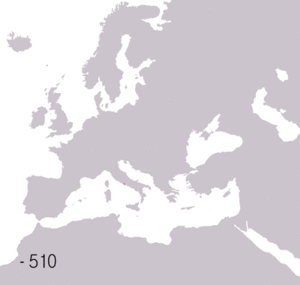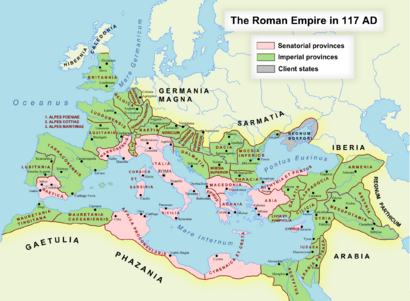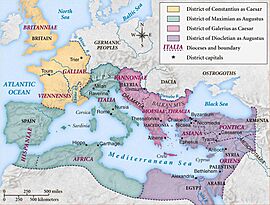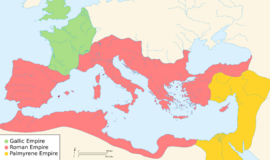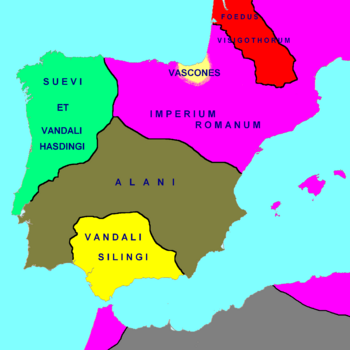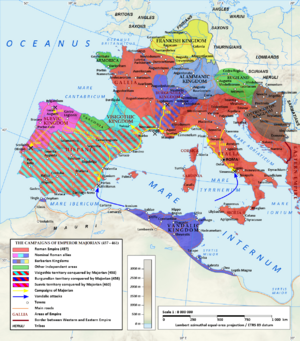Fall of the Western Roman Empire facts for kids
The fall of the Western Roman Empire means that the Western Roman Empire lost its central government. This happened over time. The Empire could no longer control its huge lands. Instead, different groups took over parts of its territory.
The Roman Empire became weak. Historians think many things caused this. These include problems with the army, the health of the Roman people, and the economy. Also, the emperors had trouble ruling. There were fights for power. Changes in religion and problems with government also played a part.
Outside the Empire, barbarians (people not from Rome) put more and more pressure on its borders. Changes in weather and widespread diseases also made things worse. The reasons for Rome's fall are still studied today. They help us understand why countries sometimes fail.
In 376, many Goths and other non-Roman people entered the Empire. They were running away from the Huns. Roman forces could not defeat them. In 395, Theodosius I died after winning two civil wars. He left a weak army. The Empire was split between his two sons. But his sons were not good rulers. Goths and other non-Romans became strong enough to challenge the Empire. More barbarian groups crossed the Rhine river and other borders. The Western Empire's army became small and weak. Even with good leaders, central rule was never strong again.
By 476, the Western Roman Emperor had very little power. He had no real control over the scattered Roman lands. Barbarian kingdoms had taken over much of the Western Empire. In 476, the Germanic king Odoacer removed the last emperor in Italy, Romulus Augustulus. The Senate then sent the emperor's symbols to the Eastern Roman Emperor Zeno.
The Western Empire never became strong again. But its ideas and culture lasted for centuries. The Eastern Roman, or Byzantine, Empire kept going for hundreds of years. It remained a strong power in the Eastern Mediterranean. Historians also talk about "late antiquity". This period shows how Roman culture continued even after the government fell apart.
Contents
- Why the Western Roman Empire Fell
- Rome's Strengths and Weaknesses
- Key Events: 313–376 CE
- Key Events: 376–395 CE
- Key Events: 395–406 CE (Stilicho's Time)
- Key Events: 408–410 CE (Sack of Rome)
- Key Events: 405–418 CE (Loss of Provinces)
- Key Events: 421–433 CE (More Instability)
- Key Events: 433–454 CE (Aetius and Attila)
- Key Events: 455–476 CE (Final Years)
- After 476: The End of an Era
- Legacy of Rome
- See also
- Images for kids
Why the Western Roman Empire Fell
Historians have studied the fall of Rome for a long time. Edward Gibbon wrote a famous book about it in 1776. He thought the Empire declined because of internal problems and outside attacks. Today, experts have many ideas about why Rome fell.
Climate and Sickness
Recent studies suggest that disease and climate change were very important. From about 200 BCE to 150 CE, the weather around the Mediterranean was warm and wet. This helped farming, army recruitment, and tax collection. After 150 CE, the climate became worse. This made life harder for people. After 450 CE, the climate got even colder during the Late Antique Little Ice Age. This may have helped bring Rome down.
The Roman Empire's trade routes and safe seas helped diseases spread. Pandemics caused huge changes in population. They also led to economic crises and food shortages. The Antonine Plague (165–180 CE) killed many people. This made it hard to fight Germanic invaders. But the Roman armies usually held their borders.
Mass Migrations and Invasions
Starting in 376, huge groups of people moved into the Empire. They were pushed by the Huns, who might have been moving because of climate change. These barbarian invasions led to barbarian kingdoms forming in much of the Western Empire. The final blow came when Rome was already weak.
Political Problems
Aurelian reunited the Empire in 274. Later, Diocletian and other emperors reorganized it. They focused more on the military. Diocletian tried to share power. He had a senior emperor (Augustus) and a junior emperor (Caesar) in each half of the Empire. But this system, called the tetrarchy, soon broke down. After that, civil wars often decided who would be the next emperor.
The Empire sometimes let barbarian groups settle inside its borders. They were given land and duties. Many became workers or soldiers for Rome. Their leaders sometimes became Roman officers. This usually worked well. But it needed a strong Roman army to make sure they followed the rules.
Money Troubles
The Empire faced many serious problems in the third century. The rising Sassanid Empire defeated Roman armies three times. There were also many civil wars and barbarian invasions. The Plague of Cyprian (from 250 CE) caused many deaths. For a short time, the Empire split into three parts. Rome also gave up the province of Dacia in 271.
The Empire survived this "Crisis of the Third Century." It focused its economy on defense. But this made the government more centralized and bureaucratic. Too much military spending and civil wars led to higher taxes. This hurt businesses. Cities lost their local tax money. Public building projects also slowed down.
Social Issues
New emperors like Aurelian openly called themselves "lord and god." This was different from earlier emperors who were seen as "first among equals." The court became very formal. People had to flatter the emperor. Emperors received information only through their courtiers. This meant they might not know what was really happening.
Some historians say that cruelty and corruption became more common. The richest families avoided most taxes. They gained more and more wealth. But they stopped being involved in the military. This led to a big gap between the rich and the poor.
Many soldiers and officers in the late Roman army were from barbarian groups. Some people saw this as a weakness. But others say that as long as the army was well-led, trained, and paid, these soldiers were loyal and effective.
Geography and Defense
The Eastern Roman Empire had a geographic advantage. It was harder for invaders to reach its main areas. The city of Constantinople was well-fortified. The European border of the Western Empire was very long and easier to cross. Barbarian attacks made the Western border provinces poor. This constant pressure made it hard for the Empire to manage its government and money. This played a big part in the fall of the West.
Rome's Strengths and Weaknesses
The Roman Empire was largest under Trajan (98–117 CE). It was a rich state. It had many trained soldiers. The government was well-organized. Educated Romans believed their way of life was the best. This gave the Empire a strong sense of unity. Trade networks allowed people to get goods from far away.
The Empire was strong and flexible. Its financial system collected taxes to support a large army. Ambitious noblemen could gain experience in both military and civil jobs. City governments worked well locally. They had their own money and properties. People wanted to be on city councils. Emperors usually chose good successors. This helped avoid civil wars.
However, Rome still had problems. It was an early subsistence economy. This means most people only grew enough food for themselves. They didn't understand how diseases spread. Even with aqueducts, hygiene was not good. Sewage was often in the streets. Local crop failures could cause famines. Women needed to have many children to keep the population stable. Infant mortality was very high. Diseases like Malaria were common.
Rise of Christianity and Army Changes
In 313, Constantine the Great allowed Christianity. Over time, Christianity became the main religion. The Christian Church became very wealthy. Huge amounts of money were used to build churches and help the poor. Bishops in rich cities became powerful.
Some people worried that the growing number of clergy, monks, and nuns took away men who could have been soldiers. The number of regular soldiers might have gone down in the fourth century. Army payrolls were sometimes inflated, meaning money was stolen. Soldiers sometimes focused on getting money from civilians instead of training. But problems like corruption were not new to the Roman army. Historians disagree on whether the army's effectiveness really declined before 376.
Key Events: 313–376 CE
Constantine settled Franks near the Rhine river. This showed that Rome had lost some control there. Later, bandits took over areas within the Empire. German tribes also became stronger. In Gaul, there was a lot of insecurity and economic decline. Many Roman country homes were empty by 350.
In 350, a general named Magnentius declared himself Emperor in the West. He took many soldiers from the Rhine border to fight a bloody civil war against Constantius II in the East. Magnentius lost and died. Constantius then invited German tribes to attack Gaul. They took over a large area.
Julian (360–363 CE) won battles against Germans in Gaul. He fought against corruption. This allowed taxes in Gaul to be cut by two-thirds. He also supported pagan religions. He died during an expensive campaign against the Sasanian Persians.
Julian's successor, Jovian, had to give up land to the Persians to get his army home. The brothers Valens (364–378 CE) and Valentinian I (364–375 CE) worked hard to fight barbarian attacks. They also tried to lower taxes. They were Christians but generally tolerated other beliefs. Valentinian died while shouting at German leaders. His young sons, Gratian and Valentinian II, became emperors in the West. Gratian removed pagan symbols from the Senate House.
Key Events: 376–395 CE
Battle of Adrianople
In 376, many Goths crossed the Danube river. They were running from the Huns. Corrupt Roman officials treated them badly. So, the Goths took up arms. More Goths, Alans, and Huns joined them. Emperor Valens attacked them in 378 with his Eastern army. In the Battle of Adrianople, Valens and much of his army were killed. This left all the Balkan provinces open to raids. Cities were safe behind their walls, but the countryside suffered greatly.
Theodosius I and Civil Wars
Gratian appointed Theodosius as a new emperor. Theodosius slowly brought back Roman control in the East. But he had to rely on barbarian fighters who were not as disciplined as Roman soldiers. The Goths were allowed to settle inside the Empire. This was a new thing. They were not fully controlled by Rome.
Theodosius faced a powerful challenger in the West, Magnus Maximus. Maximus took over Gaul, Hispania, and Britannia. He killed Gratian. Theodosius fought and defeated Maximus in 388. This caused heavy losses on both sides.
Later, Theodosius appointed Arbogast, a Frankish general, to protect the young Western Emperor Valentinian II. Valentinian died, and Arbogast chose Eugenius as the new Western Emperor. Eugenius and Arbogast led another army against Theodosius. They were defeated at the Battle of the Frigidus. This battle also caused many deaths, especially among Theodosius's Gothic allies. The areas leading into Italy were never properly defended again.
Theodosius died in 395. He left the Empire to his young sons, Honorius in the West and Arcadius in the East. Neither son was a strong ruler. They were controlled by their advisors. The Empire was no longer under one strong leader.
Key Events: 395–406 CE (Stilicho's Time)
The Roman military became very weak. There was little training or discipline. Soldiers were not paid or supplied well. Corruption was a big problem. Rich senators did not want to pay for the army. They also did not want their workers to join the army.
Stilicho, a general married to Theodosius's niece, became the main power in the West. He tried to unite the Eastern and Western courts. But the East did not trust him.
Alaric, a Gothic leader, was disappointed he didn't get a higher rank. He led his Gothic tribesmen to attack Roman lands. Alaric's people could not settle down. They also did not want to leave the Empire and face the Huns again. Stilicho could not defeat or control Alaric's group.
Invasions and Stilicho's Downfall
Alaric's forces attacked Roman Greece. Stilicho tried to stop them. But his own Eastern soldiers wanted to go home. Many went to Constantinople and killed the Eastern minister, Rufinus.
In 398, the governor of Africa stopped sending grain to Rome. Italy could not feed itself. Stilicho sent his last soldiers to take back Africa. He also married his daughter to Emperor Honorius. Stilicho was desperate for soldiers. He even asked Roman soldiers to let their slaves fight.
In 401, Alaric invaded Italy. He drove Honorius from his capital and surrounded him. Stilicho returned and fought Alaric in two battles. The Goths were weakened. They were allowed to go back to Illyricum. Stilicho hoped this would give him time to rebuild the government and army.
In 405, another group of Goths, led by Radagaisus, invaded Italy. They caused much damage. Stilicho gathered his forces, including Huns and Alans, and defeated them. He forced 12,000 prisoners to join his army.
In 406, Stilicho heard of new invaders and rebels in the northern provinces. He made peace with Alaric. The Senate did not like this peace. They felt it was like giving up. Stilicho still paid Alaric a large amount of gold.
In 407, Stilicho's daughter, Empress Maria, died. Her sister married Honorius. In 408, the Eastern Emperor Arcadius died. Stilicho planned to go to Constantinople. But a coup d'état (a sudden takeover) happened at Honorius's court. Stilicho was arrested and killed.
Key Events: 408–410 CE (Sack of Rome)
Rome's Army Disappears
After Stilicho's death, the families of the barbarian soldiers were massacred. These soldiers then joined Alaric. Italy was left without a strong army. The governor of Africa, who was against Stilicho, controlled Rome's grain supply. He only sent food to Honorius's government.
Alaric was now an "enemy of the Emperor." He could not collect taxes or hold cities easily. He offered to move his men to Pannonia for money and a small title. But he was refused. Alaric then moved into Italy and threatened Rome.
Alaric Attacks Rome
Alaric's first siege of Rome in 408 caused a terrible famine. The city paid a large sum to make him leave. Rich senators contributed little. Alaric also recruited many slaves from Rome.
Alaric tried to negotiate with Honorius again. But Honorius refused. Alaric then surrounded Rome again. He captured Galla Placidia, Honorius's sister. The Senate was desperate. They made Priscus Attalus a puppet emperor under Alaric. But Attalus could not get grain from Africa. The famine in Rome got worse. Alaric removed Attalus after a few months.
In 410, Alaric took Rome by starvation. His men sacked the city for three days. But there was not much destruction. Many barbarian slaves joined him. Rome had not fallen to an enemy in over 800 years. This event shocked the Empire. People debated why it happened. Some blamed paganism, others Christianity. Augustine of Hippo wrote his famous book "City of God" about it.
A funny story says that Emperor Honorius thought the news of Rome's fall was about his pet chicken named "Roma." When he learned it was the city, he was relieved.
Goths Leave Italy
Alaric then moved south, planning to sail to Africa. But his ships were wrecked. He died soon after. His successor, Athaulf, moved his people, now called the Visigoths, into Gaul. They were still seen as outsiders by the Romans.
Key Events: 405–418 CE (Loss of Provinces)
In 405/6, huge numbers of Germanic and Alan barbarians crossed the Rhine into Gaul. They were likely fleeing the Huns. For years, these tribes wandered, looking for food. Roman forces fought each other instead of the invaders.
The remaining troops in Britannia chose their own emperors. The last one, Constantine III, took an army from Britannia to Gaul. He controlled Gaul and parts of Hispania. But in 410, the Roman towns in Britannia rebelled against Constantine. They asked Honorius for help. Honorius told them to defend themselves. After this, no central Roman government appointed officials in Britannia.
In 411, Jovinus rebelled in Gaul. He relied on the support of Burgundians and Alans. Athaulf, the Visigoth leader, defeated Jovinus. The Burgundians were settled on the Rhine. All the rebel emperors were defeated. But large barbarian groups remained in Gaul and Hispania.
The Visigoths Settle in Gaul
In 416, the Visigoth leader Wallia made a deal with the Roman general Constantius. Wallia sent Honorius's sister, Galla Placidia, back to Rome. In return, he received food. From 416 to 418, Wallia's Goths fought for Rome in Hispania. They defeated other barbarian groups.
In 418, Wallia's Goths were given land to farm in Aquitania (southern Gaul). Constantius also brought back an annual meeting for the southern Gallic provinces. Constantius rebuilt the Western army. But he had to use barbarians and frontier troops to do it.
This settlement was a success for Rome. But it meant huge losses of land and money. The river Loire became the northern border of Roman Gaul. Franks controlled large areas in eastern Gaul. Even in southern Gaul and Hispania, large barbarian groups remained. They had their own military and social systems. They sometimes accepted Roman rule, but they mostly followed their own interests.
Key Events: 421–433 CE (More Instability)
Constantius died in 421. He had been a strong general. His death led to over ten years of instability. Honorius could not control his own court. Galla Placidia, Constantius's wife and mother of the young Valentinian III, fled to the Eastern court.
Honorius died in 423. After some struggles, the Eastern Roman government made the child Valentinian III emperor. His mother, Galla Placidia, ruled for him. Aetius, a powerful general, became the main military leader.
The Empire continued to weaken. Hispania slipped out of Roman control. The Rhine border collapsed in Gaul. The Visigoths attacked again. Franks became powerful in the northeast. Aetius fought hard and won many battles. But the Empire was still in trouble.
In 428, the Vandals and Alans, led by the strong king Genseric, crossed from Hispania to Africa. They defeated the Roman governor, Boniface. Aetius and Boniface later fought each other. Boniface was mortally wounded. Aetius became the most powerful general in Italy.
Key Events: 433–454 CE (Aetius and Attila)
Aetius worked hard to stabilize Gaul and Hispania. He relied heavily on his Huns allies. The Huns attacked the Burgundiones, making them Roman allies. This brought some Roman control back to Trier. Eastern Roman troops helped stop the Vandals in Africa.
In 439, the Vandals captured Carthage. They set up the Vandal Kingdom, an independent state with a strong navy. This caused a big financial crisis for the Western Empire. Africa was a rich province. It provided much tax money and grain for Rome. Roman troops gathered in Sicily for a counter-attack. But it never happened.
The Vandals became a constant danger to Roman trade and coasts. In 442, Genseric made a good peace deal with Rome. He kept his new lands. But the Empire lost a lot of income from Africa. This forced Rome to raise taxes. But the peasants could not pay more. Rich people also avoided taxes.
Attila the Hun Attacks
In 444, the Huns united under Attila. He attacked the Eastern Empire until 450, demanding huge sums of money.
Attila then turned to the West. He claimed the Emperor's sister, Honoria, as his wife. He also demanded half of the Western Empire. When he was refused, he invaded Gaul in 451 with a huge army. In the bloody battle of the Catalaunian Plains, Aetius and his Roman and barbarian allies stopped Attila.
In 452, Attila invaded Italy. He marched towards Rome. But disease in his army, lack of supplies, and pleas from Pope Leo I made him stop. Attila died unexpectedly in 453. His empire fell apart as his followers fought for power.
In 454, Aetius was killed by Emperor Valentinian III. Valentinian himself was murdered a year later by Aetius's supporters. A rich senator, Petronius Maximus, took the throne. He angered the Vandals. A Vandal fleet arrived in Italy. Petronius tried to flee Rome but was killed by a mob. The Vandals sacked Rome for two weeks. They took much treasure and the princess Eudocia.
Key Events: 455–476 CE (Final Years)
Avitus, with Visigothic support, became Emperor in 455. This was the first time a barbarian kingdom played a key role in choosing an emperor. But Avitus was defeated by Majorian and Ricimer, commanders of the remaining army in Italy. Avitus was forced to become a bishop and died soon after.
Majorian's Brief Comeback
Majorian became Emperor in 457. He was a strong leader. He rebuilt the army and navy. He tried to take back Gaul and Hispania. He defeated the Visigoths and Burgundians. He also brought back some Roman control in Hispania. Majorian prepared a fleet to retake Africa from the Vandals.
But his fleet was burned by traitors. Majorian made peace with the Vandals. When he returned to Italy, Ricimer arrested and executed him. Ricimer, who was part barbarian, could not become emperor himself. He controlled Italy through puppet emperors.
Eastern Empire's Help and Final Emperors
In 467, the Eastern Emperor sent Anthemius, a strong general, to be the Western Emperor. Anthemius married his daughter to Ricimer. In 468, the Eastern Empire sent a huge army to help retake Africa. But the Vandal king Genseric used fireships to destroy most of the Roman fleet. The Vandals kept Africa.
Anthemius and Ricimer later fought. Ricimer besieged Anthemius in Rome. Rome surrendered after months of starvation. Anthemius was captured and killed in 472. Ricimer died soon after.
After more struggles, Julius Nepos became emperor in 474. He was supported by the Eastern Emperor. Nepos appointed Orestes as his top general. In 475, Orestes promised land to Germanic soldiers for their support. He then drove Julius Nepos out of Italy. Orestes made his own young son, Romulus Augustulus, emperor. Romulus was not recognized outside Italy.
In 476, Orestes refused to give the soldiers the land he promised. They rebelled under Odoacer. Orestes fled but was captured and executed. On September 4, 476, Odoacer forced Romulus Augustulus to give up his throne. Odoacer became the ruler of Italy. He sent the imperial symbols to Constantinople.
After 476: The End of an Era
The Western Roman Empire is usually said to have ended on September 4, 476. But this is not a simple end. In Roman law, the Empire was just reunited under one emperor in the East. Some parts of the Western Empire continued under Roman-like rule. Julius Nepos still claimed to be Emperor until his murder in 480. Syagrius ruled a Roman area in Gaul until 486.
Odoacer ruled Italy. He negotiated with the Eastern Emperor Zeno. Zeno accepted Odoacer as his representative in Italy. But Zeno insisted that Odoacer recognize Julius Nepos as the Western Emperor. Odoacer did not give Nepos any real power. But he did make coins in Nepos's name.
In 488, the Eastern Emperor allowed Theoderic, a Goth, to take Italy. After some fighting, Theoderic and Odoacer agreed to rule together. But Theoderic's men murdered Odoacer in 493.
The Western Roman Senate in Rome continued to exist under Gothic and later Byzantine rule for about another century. It finally disappeared in the early 600s.
Legacy of Rome
The Roman Empire was more than just a government. It was a huge civilization. It included manufacturing, trade, and amazing architecture. People could read and write. There were written laws and a common language for science and literature.
Many of these cultural practices were lost in the West after the Empire fell. But they were slowly rebuilt in the Middle Ages. This Roman heritage formed the basis for the development of Europe.
Historians now see the fall of Rome as a "complex cultural transformation." It was not just a sudden collapse. Roman culture continued to change and adapt even after the political control was lost.
See also
- Succession of the Roman Empire
- Comparative studies of the Roman and Han empires
- Decline of the Byzantine Empire (Fall of the Eastern Roman Empire)
- Historiography of the fall of the Western Roman Empire
- Last of the Romans
- Late Roman army
- List of Roman civil wars and revolts
 In Spanish: Caída del Imperio romano de Occidente para niños
In Spanish: Caída del Imperio romano de Occidente para niños
Images for kids
-
Solidus of Julian, c. 361. Obverse: Julian with the beard appropriate to a Neoplatonic philosopher. Inscription: FL(AVIVS) CL(AVDIVS) IVLIANVS PP(=Pater Patriae, "father of the nation") AVG(=Augustus). Reverse: an armed Roman, military standard in one hand, a captive in the other. Inscription: VIRTVS EXERCITVS ROMANORVM, "the bravery/virtue of the Roman army"; the mint mark is SIRM, Sirmium.
-
Chi-rho pendant of Empress Maria, daughter of Stilicho, and wife of Honorius, now in the Louvre, Paris. The pendant reads, around a central cross (clockwise):
HONORI
MARIA
SERHNA
VIVATIS
STELICHO.
The letters form a Christogram. -
The Eastern and Western Roman Empire at the death of Theodosius I in 395
-
Tremissis of Anthemius


